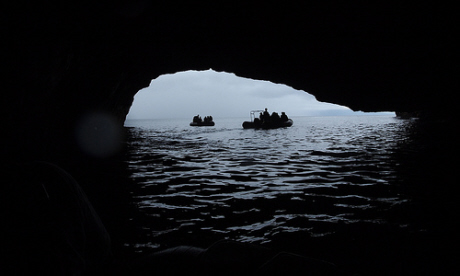
Mark Carwardine finds the Galápagos Islands as rewarding as ever, but now far busier than is good for them
I’d love to know what people lug around in their bulging, overweight suitcases and zip-busting carry-on bags. It looks as if they’ve been evacuated from their homes and are escaping with all their worldly goods stuffed into every available piece of luggage. If I didn’t a) dive, b) work in wilderness areas where I have to be largely self-sufficient, and c) take photographs for a living, I swear I could go away for two weeks with little more than a bum bag. But I suppose that, like me, everyone has their reasons for travelling with too much stuff.
I’ve just returned from a two-week trip to the Galápagos Islands, 1,000km off the coast of Ecuador, fully laden as always. This time KLM charged me US$688 (£340) for the privilege of carrying my essential ‘excess’. So in future I’ve vowed to cut back by travelling without reading material, toiletries or clothes. It’s the only way.
I’d left for the Galápagos in high spirits. But the sudden dent in my bank balance, losing my brand new laptop at the check-in counter, and then the gruelling journey home (Baltra–Guayaquil–Quito–Bonaire–Amsterdam–Bristol – complete with an engine failure over the English Channel that sent us back to Amsterdam for a second attempt in a new aircraft) sapped my enthusiasm long before arriving back in the UK.
This was my second visit to Charles Darwin’s ‘Enchanted Isles’ and, again, it lived up to expectations. I snorkelled with sea lions, Galápagos and white-tipped reef sharks, penguins and green sea turtles. I sat with breeding waved albatrosses as they performed their extraordinary bill-circling, swaggering courtship displays (they looked rather like Samurai warriors performing Lord of the Dance).
I watched magnificent male frigatebirds showing off with the ultimate party trick – turning their wrinkled throat sacs into extraordinary, fully-inflated red balloons. And I carefully sidestepped blue-footed boobies, marine iguanas, lava lizards, sallylightfoot crabs and a host of other mind-bogglingly tame wildlife strewn across every conceivable space on the beaches and footpaths.
In many ways, nothing much has changed since Darwin first set foot in the Galápagos back in 1835. The 13 endemic finch species that inspired his theory of evolution (and now bear his name) are still there and the wildlife is as trusting as ever.
But there are changes afoot. Insatiable Asian demand for sea cucumbers and shark fins has spawned widespread illegal fishing activities that are devastating the once-rich surrounding seas. And a rapid rise in immigration, combined with exponential economic growth, has brought lots of people with excess baggage of their own – in the form of alien mammals, insects, plants and diseases that are threatening the archipelago’s fragile ecology.
Perhaps the most conspicuous change in recent years has been in tourism. The number of tourists has trebled from 40,000 in 1991 to 120,000 in 2006. There were 16 people in our group, but at almost every anchorage tourists accompanied us from as many as five other yachts. In places, the well-worn paths were as busy as a high street pavement at lunchtime. On one occasion, on Española Island, a lone albatross sat, resolutely, on her nest surrounded by three tour groups – no fewer than 48 people altogether.
It was strange to explore such remote islands as one of a crowd, and to encounter wildlife so tame. I didn’t like it, and felt guilty for being part of the scrum.
All these threats are so severe that Ecuador’s president, Rafael Correa, recently declared the Galápagos Islands to be in crisis. As always, any remedial action is likely to be too little, too late. But one solution he has proposed is indisputably essential – limit the number of tourists. And perhaps, as a bonus, they’ll be allowed to take a little more luggage?
Mark Carwardine is an award-winning wildlife writer, broadcaster and photographer